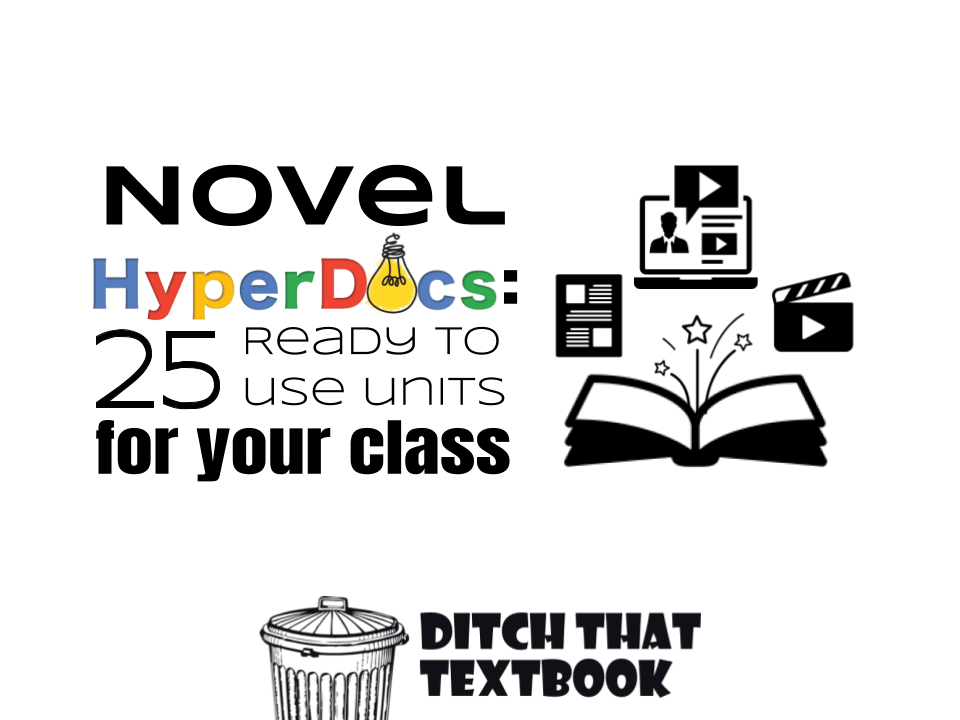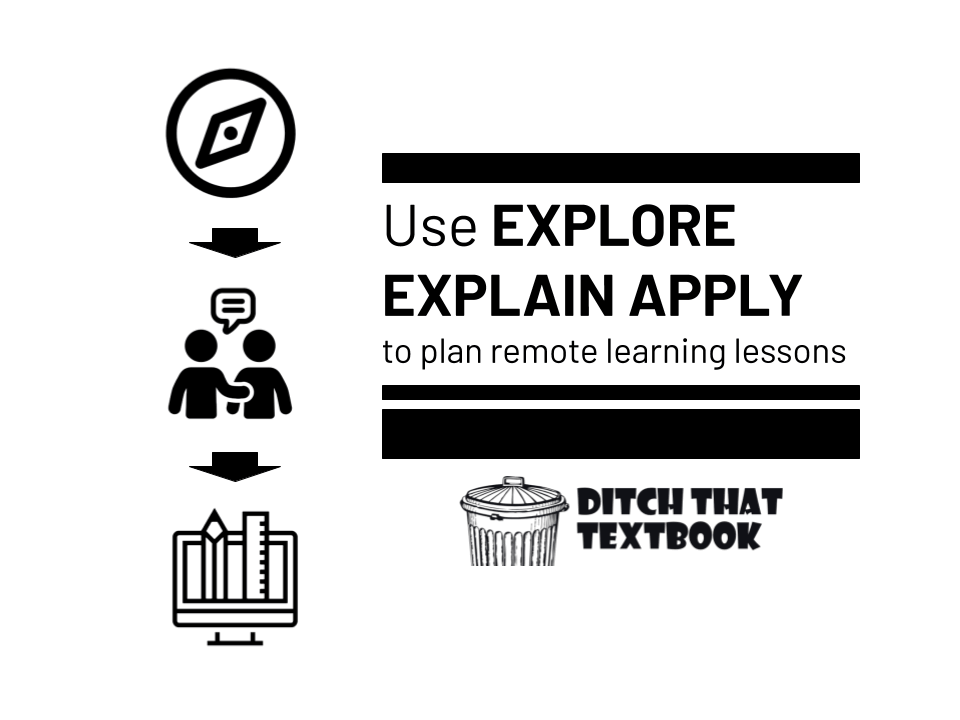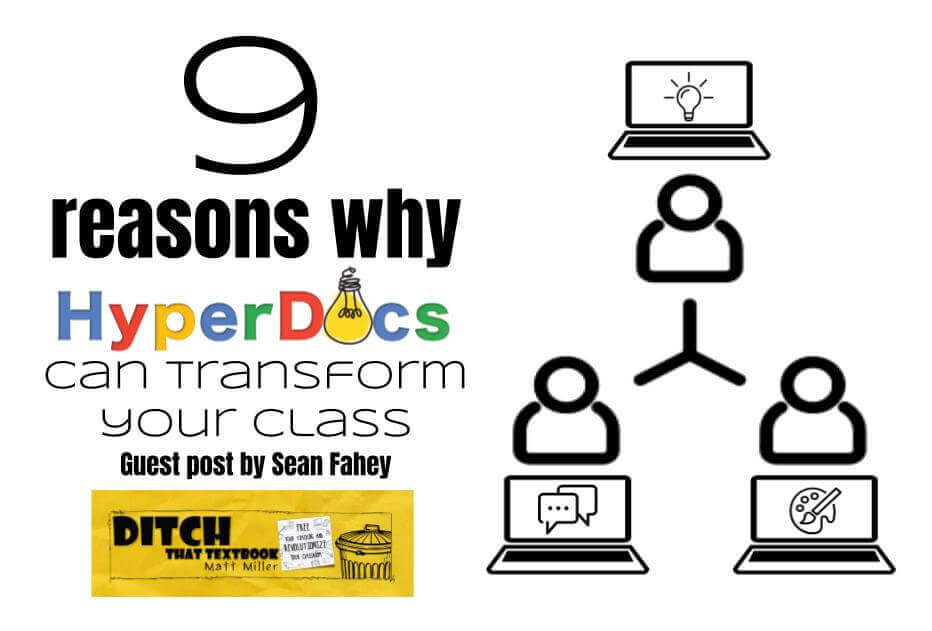Novel HyperDocs take the old curriculum guides we know and turn them into engaging blended learning units of study. Here ...



Put learning in the hands of your students. Use the Explore Explain Apply method to guide your remote learning lesson planning. Here's how.
Post by Karly Moura (@KarlyMoura) and Matt Miller (@jmattmiller)
Have you ever had someone tell you, "I'm going to teach you a lesson"?
Teaching a lesson implies control -- as in, someone else has control over you.
Teaching someone a lesson can also be synonymous with getting revenge with someone. You know ... when your classmate did something to wrong you and you thought, "I'll teach that kid a lesson!"
Teaching a lesson is a very top-down approach to learning. Teacher teaches. Student listens.
There's a better way, though, and it's a great fit for lots of kinds of student learning. It's the Explore Explain Apply method.
Explore Explain Apply is a subset of the HyperDocs framework created by California educators Lisa Highfill, Kelly Hilton and Sarah Landis. For more information on HyperDocs, visit hyperdocs.co.
This method -- Explore Explain Apply -- is a GREAT fit for remote learning.
Let's compare it to the traditional approach we've used in classrooms for a long time. Then, let's see how it can be applied.
The very traditional approach to teaching and learning new content looks like this:
Lecture and read: This is the input part of learning. Teachers teach. Students read out of the textbook. Limitation: Students don't have much agency in learning. It's something done to them.
Worksheets: Worksheets ask students questions, giving them practice with the new material. Limitation: The questions students answer often don't help them place the material in the bigger picture.
Quiz: A quiz also asks questions, but this time to assess how well the student grasps the new material. Limitation: Asking closed-ended questions often doesn't paint a clear picture of how well developed a student's understanding is. It can lead to a game of "gotcha", catching students with questions they can't answer.
There's a different way to assess. This framework -- explore, explain, apply -- puts learning in the hands of the students, encouraging them to take control of their learning from start to finish. This lesson design has been a powerful framework for designing HyperDocs.
Explore: Students gather background knowledge on a topic on their own. This can be through articles, videos, images, and more.
Explain: The teacher fills in the holes with explanation. This can be whole-group instruction, or it can be teacher-provided videos, articles, images, and more.
Apply: Students take what they've learned and use it. They create something to show what they know instead of just answering questions.
The framework for an Explore Explain Apply HyperDoc is simple, yet provides the teacher and the students with a concrete way to dive into a well thought out digitally designed lesson.
Open your own copy of this template (created by Lisa Highfill, Kelly Hilton and Sarah Landis) to follow as we dive into building an Explore Explain Apply HyperDoc.
Explore: Insert links, images, videos, or articles which allow students to independently build background knowledge for a topic.
Possible resources:
Explain: Add video, articles, or pause for a whole group lesson to explain the content.
Possible resources:
Apply: Post instructions for the method students will be using to apply their knowledge from the lesson and share with an authentic audience. Tip: Use images and bullet point steps to simplify the process.
Possible resources for apply:
A quick note about Google and Microsoft ...
Many of the Explore Explain Apply / HyperDocs examples in this post are shared in Google Docs. They can be used for any productivity suite, including Microsoft. If your students use Microsoft 365, just go to File > Download as > Microsoft Word .docx. That document can be shared via Teams.
The Explore Explain Apply framework allows for multiple opportunities for students to receive feedback and to create checkpoints throughout the lesson. With a student task in each section teachers can provide valuable feedback for students before they get to to the final apply section.
Explore student task:
Add instructions, guiding questions, or expectations for their exploration.
Have students respond in a text box. An icon such as a pencil lets students know they are expected to type something.
For middle and high school having students respond in a Google Form or on a Padlet helps with workflow.
Explain student task:
Post learning expectations for students.
Will they take notes? Possibly share their thinking digitally or on paper? A 3-2-1 reflection would work for this.
Give students feedback during this task either digitally or in person. Possibly give students the opportunity to give feedback to one another as well.
Apply student task:
Include expectations for student creations. This could include due dates, links to rubrics, and instructions for turning work in. Give students feedback during this task either digitally or in person. Possibly give students the opportunity to give feedback to one another as well.
Possible resources: Include a link to a Show What you know BINGO board and have students share their work on Flipgrid, Wakelet or in a collaborative slides presentation. Students can give feedback to one another by using the commenting feature in Padlet and slides or by recording a response in Flipgrid.Below you will find a Wakelet collection of templates along with lots of ready to use HyperDoc lessons designed using the explore, explain, apply framework.
Click on the left/right arrows to scroll through the entire collection or click here to view it in a new tab.
You'll notice that some of these HyperDocs look very different from one another even though they are using the same template. That's the beauty of digital lesson design! YOU get to design the lesson the way it works for you and your students. Change the colors, add images, experiment with different fonts and try out different creation tools. A HyperDoc can be created with Google Docs, Microsoft Word, Adobe Spark Page, ThingLink, Canva or even Seesaw!

Novel HyperDocs take the old curriculum guides we know and turn them into engaging blended learning units of study. Here ...

HyperDocs have taken the education world by storm. But what are they? And how do we start using them in ...

How can we incorporate great pedagogy, the best content and meaningful technology into our classroom? HyperDocs! Here are 9 reasons why ...
For notifications of new Ditch That Textbook content and helpful links:
Matt provides in-person and virtual keynotes, workshops and breakout sessions that equip, inspire and encourage teachers to create change in their classrooms. Teachers leave with loads of resources. They participate. They laugh. They see tech use and teaching in a new light. Click the link below to contact us and learn how you can bring Matt to your school or district!
Is Matt presenting near you soon? Check out his upcoming live events!

Session expired
Please log in again. The login page will open in a new tab. After logging in you can close it and return to this page.
[…] These are just a few of the tools you can use to create your own HyperDoc. If you still need a bit more guidance before you jump right into creating you may want to try using a template to get started. This adaptation of the Explore, Explain, Apply template has links to more tools and resources for you to refer to when creating. Also check out Use Explore Explain Apply to plan remote learning lessons. […]
[…] Use Explore, Explain, Apply to plan remote learning lessons by Matt Miller on Ditch That Textbook […]
[…] Use Explore Explain Apply to plan remote learning lessons […]
GENIUS….;;);));
[…] Read the full story by Ditch That Textbook […]
Awesome Matt, I just made my lesson template copies and will be inputting my remote lessons to students by ditching the old ways of book and pencil too. SO glad I attended Spring CUE and am subscribing here.. I can’t wait for the “pirate” book to come out too! ARG!!!